You’ll design sustainable jewelry by focusing on five core principles: sourcing recycled metals and lab-grown gemstones that reduce mining impact by 90%, creating timeless designs built for generations rather than fast fashion, implementing ethical sourcing with fair labor practices, minimizing waste through circular manufacturing that cuts emissions by 80%, and maintaining complete supply chain transparency. These fundamentals guarantee your pieces aren’t just beautiful—they’re environmentally responsible and socially conscious investments that support artisans worldwide while protecting ecosystems for future generations.
Understanding Sustainable Jewelry Design Fundamentals
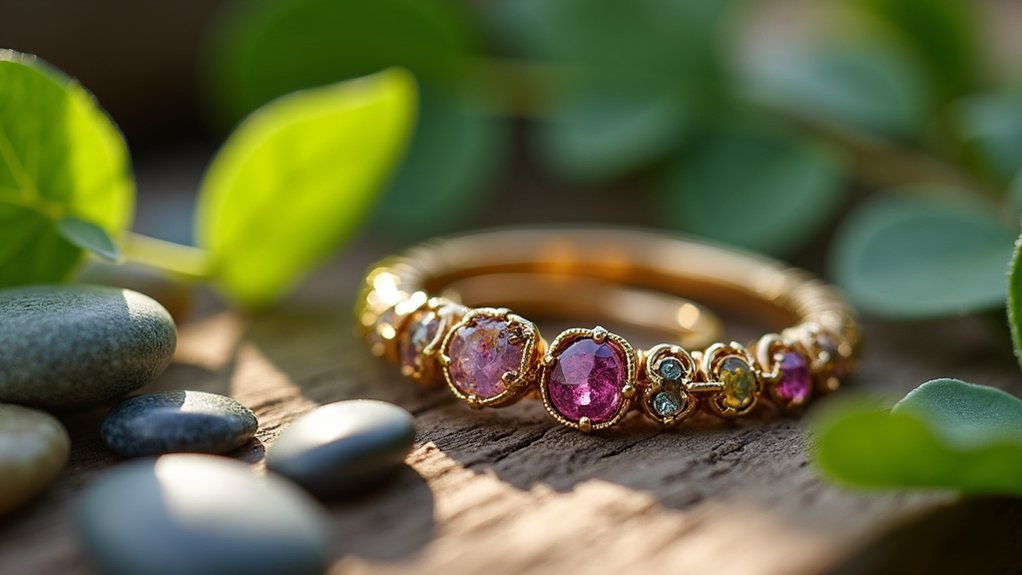
When you’re exploring sustainable jewelry design, you’re embracing a philosophy that fundamentally shifts how the industry approaches creation and consumption. This approach prioritizes crafting durable pieces that’ll last generations, directly challenging fast-fashion mentality.
You’ll focus on environmental responsibility by considering each piece’s complete lifecycle impact, working to minimize waste and ecological damage throughout production.
Ethical sourcing becomes your foundation, ensuring metals and gems aren’t linked to child labor or conflict zones.
Building ethical foundations means sourcing metals and gemstones free from child labor exploitation and conflict zone connections.
You’ll incorporate recycled materials like reclaimed metals and lab-created stones, dramatically reducing mining’s environmental footprint. Fair trade practices guide every decision, guaranteeing artisans receive proper wages and treatment.
Material Selection for Environmental Responsibility
You’ll make the greatest environmental impact by choosing recycled metals like gold and silver, which dramatically reduce mining demands and ecosystem disruption.
Lab-grown diamonds and gemstones offer you identical beauty and quality to mined stones while eliminating the environmental damage of extraction operations.
These material choices let you create stunning jewelry that aligns with your environmental values without compromising on aesthetics or durability.
Recycled Metals Usage
Since traditional mining operations devastate ecosystems and consume enormous amounts of energy, choosing recycled metals represents one of the most impactful decisions you can make in sustainable jewelry.
When you select recycled gold, silver, or platinum for your jewelry production, you’re markedly reducing environmental impact by saving up to 90% of the energy required for mining new materials. This significantly cuts your carbon footprint while supporting ethical sourcing standards.
You’ll find that recycled metals offer the same quality as newly mined materials but with certification from organizations like the Responsible Jewelry Council.
These sustainable practices align with circular economy principles, giving old materials new life. With 80% of jewelry gold already sourced from recycled materials, you’re joining an established movement toward environmental responsibility.
Lab-Grown Gemstone Benefits
Just as recycled metals revolutionize sustainable sourcing, lab-grown gemstones offer another powerful solution for environmentally conscious jewelry choices.
You’ll find these stones deliver identical quality to mined alternatives while eliminating ethical concerns related to conflict diamonds and human rights violations.
Your environmental impact drops dramatically when choosing lab-grown options—they use 80% less water and produce 90% fewer carbon emissions.
Many producers harness renewable energy during creation, further reducing their footprint. You’re also getting better value, as lab-grown gemstones cost up to 40% less than mined stones.
These innovations make sustainable jewelry accessible without sacrificing beauty or durability.
You can confidently wear pieces knowing they support responsible practices throughout the supply chain.
Ethical Sourcing and Supply Chain Transparency

When you’re shopping for jewelry, ethical sourcing guarantees that every material in your piece comes from suppliers who treat workers fairly, pay living wages, and maintain safe working conditions. Supply chain transparency lets you trace exactly where your gemstones and metals originated, ensuring they’re conflict-free and responsibly mined.
| Traditional Sourcing | Ethical Sourcing |
|---|---|
| Unknown worker conditions | Fair labor practices guaranteed |
| Potential conflict materials | Certified conflict-free origins |
| Environmental damage | Strict environmental standards |
Look for certifications from the Responsible Jewelry Council when selecting brands. These verify compliance with social and environmental standards throughout the entire supply chain. By choosing transparent companies that disclose their sourcing practices, you’re supporting sustainable mining operations and promoting positive change within the jewelry industry.
Durability and Timeless Design Principles
Beyond responsible sourcing, creating jewelry that lasts becomes equally important for true sustainability.
You’ll want to prioritize durability through high-quality materials and robust production methods like soldering and riveting. These techniques guarantee your pieces withstand daily wear while reducing replacement frequency.
Focus on timeless designs that transcend fleeting trends. Classic aesthetics remain appealing for years, encouraging customers to invest rather than dispose.
When you incorporate eco-friendly materials such as recycled metals and lab-grown gemstones, you’re enhancing both durability and environmental responsibility.
Design your sustainable jewelry with repairability in mind. Create pieces that can be easily fixed or repurposed, supporting a circular economy.
This approach extends product lifecycles while aligning with sustainable fashion principles that benefit both consumers and the planet.
Recycled and Upcycled Material Integration
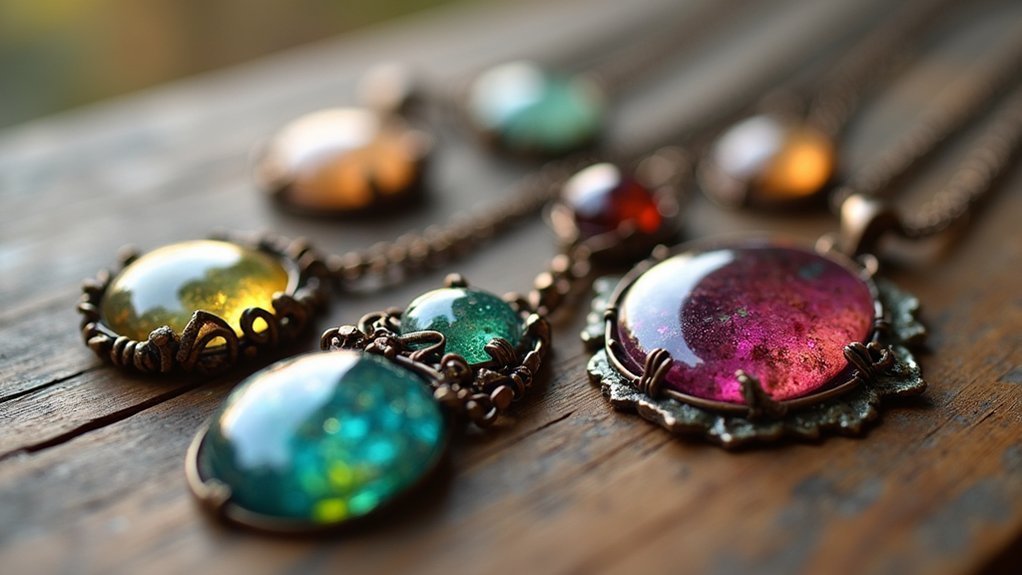
You can greatly reduce your jewelry’s environmental impact by incorporating recycled metals and upcycled materials into your designs.
When you source recycled gold, silver, and platinum, you’ll cut energy consumption by up to 90% while maintaining the same quality as newly mined materials.
Recycled Metal Sourcing
Although traditional metal mining devastates ecosystems and depletes natural resources, recycled metal sourcing offers a transformative solution that’ll revolutionize how you approach jewelry creation.
By choosing recycled metals over virgin materials, you’re actively combating environmental degradation while maintaining exceptional quality standards.
Here’s how recycled metal sourcing transforms your sustainable jewelry practice:
- Energy Efficiency: You’ll reduce energy consumption by up to 90% compared to traditional extraction processes, dramatically lowering your carbon footprint.
- Circular Economy Integration: Your use of sustainable materials diverts waste from landfills while promoting resource reuse across the jewelry industry.
- Cost-Effective Quality: You’ll access the same purity levels as newly mined metals at lower production costs, making sustainable choices economically viable.
Upcycled materials further enhance your designs, creating unique pieces with compelling stories.
Upcycling Old Jewelry
Transforming forgotten treasures in your jewelry box into stunning new creations represents the pinnacle of sustainable design practice. Upcycling old jewelry dramatically reduces waste while creating unique jewelry pieces with compelling histories. You’ll minimize your carbon footprint by choosing this sustainable alternative over purchasing new items.
| Environmental Benefit | Impact |
|---|---|
| Waste Reduction | 80% of jewelry waste comes from discarded pieces |
| Energy Savings | 95% less energy than mining new metals |
| Mining Prevention | Eliminates environmental degradation from new operations |
| Material Conservation | Extends lifecycle of existing resources |
When you incorporate recycled metals and gemstones from older pieces, you’re preventing environmental degradation while supporting truly sustainable practices. Each upcycled creation carries unique character that mass-produced jewelry simply can’t match.
Circular Economy Benefits
When jewelry designers embrace circular economy principles, they create a regenerative system that transforms waste into valuable resources while markedly reducing environmental impact.
By integrating recycled metals from electronic waste and old jewelry, you’re not only crafting sustainable jewelry but also cutting carbon emissions by up to 80% compared to traditional mining processes.
This circular economy approach delivers multiple benefits:
- Environmental Protection – You’ll greatly reduce waste reduction while preserving biodiversity and ecosystems threatened by mining activities.
- Economic Growth – Your demand for recycled materials creates local jobs in collection, processing, and crafting sectors.
- Creative Innovation – You’re encouraged to design unique pieces with distinct histories through ethical production methods.
You’re fundamentally building a regenerative system that benefits both planet and communities.
Energy-Efficient Manufacturing Processes
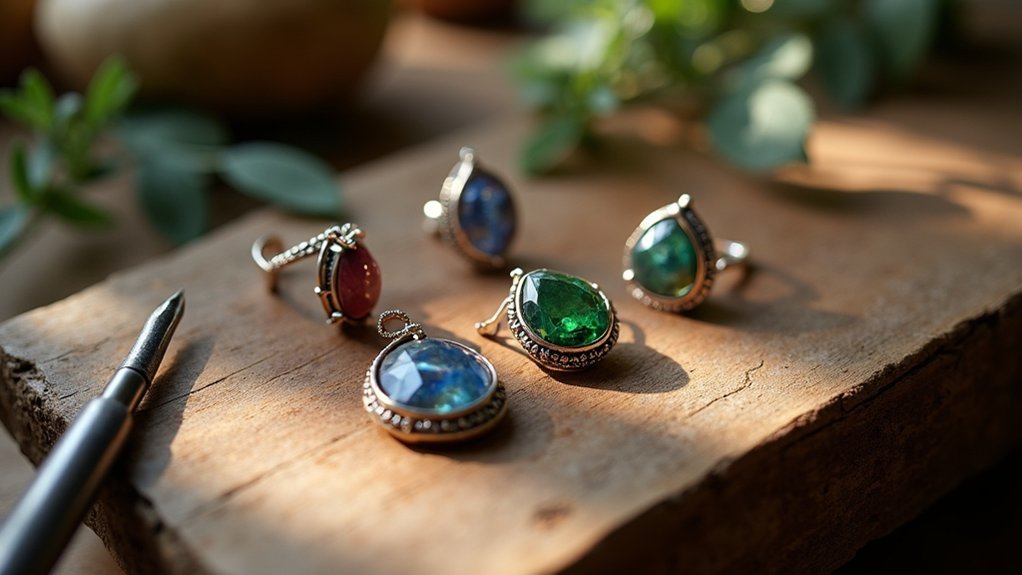
Everything about jewelry manufacturing can change when you prioritize energy efficiency in your production processes.
Energy-efficient manufacturing processes in sustainable jewelry focus on using hand tools over power equipment, dramatically cutting energy consumption while helping reduce waste. You’ll find techniques like soldering, riveting, and wire wrapping offer exceptional durability with minimal energy requirements compared to industrial alternatives.
Hand tools and traditional techniques like soldering and wire wrapping deliver exceptional durability while dramatically reducing energy consumption in jewelry manufacturing.
Smart production practices include implementing renewable energy sources like solar or wind power in your facilities.
When creating eco-friendly jewelry, choose low-impact methods such as natural finishes and eco-friendly coatings to minimize harmful chemicals. The materials used should align with sustainable principles throughout manufacturing.
These efficient approaches lower operational costs while creating a smaller ecological footprint, making your sustainable jewelry economically viable and environmentally responsible.
Minimizing Waste in Production Workflows
You’ll transform your jewelry production by implementing efficient material utilization strategies that can reduce waste by up to 30% compared to conventional manufacturing methods.
Establishing circular production systems allows you to continuously reuse materials and byproducts throughout your workflow, creating a closed-loop process that maximizes resource value.
Zero-waste manufacturing techniques, including CAD modeling and modular design approaches, enable you to eliminate virtually all production waste while maintaining high-quality output.
Efficient Material Utilization
As sustainability becomes increasingly essential in jewelry manufacturing, efficient material utilization stands as one of the most impactful ways you can reduce your environmental footprint while maintaining profitability.
By implementing strategic approaches to minimize waste, you’ll transform your production workflow while creating exceptional sustainable jewelry pieces.
Three core design strategies will revolutionize your material efficiency:
- Precision Planning with CAD Software – Simulate designs before production to eliminate wasteful elements and optimize cutting patterns for maximum yield.
- Recycled Metals Integration – Source recycled materials to reduce mining dependency while maintaining quality standards in your finished pieces.
- Circular Economy Implementation – Repurpose leftover materials from completed projects into new designs, creating a closed-loop system that virtually eliminates waste.
Circular Production Systems
While efficient material utilization forms the foundation of sustainable jewelry manufacturing, circular production systems take waste reduction to the next level by creating closed-loop workflows that transform your entire production approach.
You’ll minimize environmental impact by designing pieces for easy disassembly and recycling at their lifecycle’s end.
These closed-loop systems enable you to reclaim materials from unsold inventory, dramatically reducing raw material needs.
Zero-Waste Manufacturing Techniques
Beyond establishing circular workflows, zero-waste manufacturing techniques enable you to achieve near-perfect material efficiency by strategically redesigning how you approach each stage of production.
You’ll maximize up to 90% of raw materials through pattern-making methods that eliminate unnecessary waste. CAD technology allows you to create precise models, reducing excess material during fabrication while modular designs let you craft multiple pieces from single material sources.
Three essential zero-waste strategies include:
- Implement 3D printing to use exact material quantities needed for each piece
- Establish a recycling program for metal scraps and leftover materials
- Design modular components that minimize leftover scraps while promoting versatility
These techniques transform your production workflow into a circular economy system, repurposing resources effectively while maintaining design integrity and reducing environmental impact.
Lab-Grown Alternatives to Mined Gemstones
When you’re seeking gemstones that align with sustainable principles, lab-grown alternatives offer an identical product to mined stones without the environmental costs.
Lab-grown diamonds possess the same physical and chemical properties as mined versions, making them indistinguishable through gemological testing.
Lab-grown diamonds are chemically and physically identical to mined diamonds, making them completely indistinguishable to gemological experts.
You’ll reduce your environmental impact considerably since these metals or lab-grown gemstones avoid extensive land disruption and deforestation. Their sourcing and production consume fewer natural resources, often utilizing renewable energy to reduce carbon footprint.
You’ll also save 20-40% compared to mined diamonds without compromising quality. As acceptance grows, with 70% of consumers embracing these alternatives, choosing lab-grown options supports ethical and sustainable jewelry practices while maintaining the beauty and durability you desire.
Certification Standards and Compliance Requirements

As you navigate the sustainable jewelry market, certification standards serve as your essential guide for verifying ethical and environmental claims.
These certifications guarantee you’re purchasing authentic ethical jewelry that meets rigorous environmental and social requirements.
Key certification standards include:
- Kimberley Process (KP) – Tracks diamond origins to prevent conflict financing and human rights abuses
- Fairmined/Fairtrade Gold – Guarantees fair wages and safe working conditions for miners throughout the supply chain
- Responsible Jewellery Council (RJC) – Oversees compliance with thorough social and environmental standards
Additional certifications like SCS-007 verify sustainable materials and carbon-neutral practices, while SCS Recycled Certification confirms recycled content use.
These standards help minimize environmental impact while protecting worker rights, guaranteeing your jewelry purchases align with sustainable values.
Circular Economy Implementation in Jewelry Design
Building on these certification frameworks, jewelry brands now embrace circular economy principles to create closed-loop systems that maximize material value while minimizing environmental impact.
You’ll find that implementing these principles means prioritizing recycled materials like reclaimed metals and lab-grown gemstones, which drastically reduce resource extraction.
Focus on sustainable sourcing by choosing materials with ethical origins, such as Fairtrade or Fairmined gold that support fair labor practices.
Design your pieces for longevity and durability rather than following fast fashion trends.
You can establish take-back programs allowing customers to return old jewelry for recycling or upcycling, promoting responsible consumption while reducing waste and pollution.
This collaborative approach between you, manufacturers, and consumers creates a continuous reuse cycle that transforms the industry’s environmental footprint.
Consumer Education and Brand Transparency Strategies
While sustainable practices form the foundation of responsible jewelry production, your brand’s success ultimately depends on educating consumers about these values and demonstrating complete transparency throughout your operations.
Since 66% of global consumers willingly pay more for sustainable jewelry brands, you’ll benefit from clear consumer education strategies. Share detailed supply chains information, including sourcing practices and certifications that verify your responsible practices.
Here are three essential transparency strategies:
- Implement clear labeling – Indicate material origins and ethically sourced certifications on all products
- Share artisan stories – Use visuals and narratives showcasing the people behind your jewelry
- Gather consumer feedback – Conduct surveys and collect testimonials to enhance brand transparency credibility
This approach builds trust while fostering deeper emotional connections with environmentally conscious customers.
Frequently Asked Questions
What Are the Principles of Design in Jewelry?
You’ll apply balance, proportion, emphasis, rhythm, and unity when creating jewelry. You’ll consider scale, contrast, and harmony to guarantee your pieces are visually appealing and structurally sound for lasting wear.
What Are the Major Principles of Sustainable Design?
You’ll focus on longevity through durable craftsmanship, minimize environmental impact via responsible sourcing, use recycled materials, guarantee ethical labor practices, and support fair trade to create jewelry that’s both beautiful and socially responsible.
What Does “Sustainable” Mean in Jewelry?
You’ll find sustainable jewelry means creating pieces that minimize environmental and social harm throughout their lifecycle. It uses ethically sourced, recycled, or lab-grown materials while ensuring fair wages and safe working conditions.
How Do You Make Jewelry Sustainable?
You’ll make jewelry sustainable by using recycled metals, choosing lab-grown gemstones, adopting eco-friendly manufacturing methods, selecting biodegradable packaging, and ensuring transparent sourcing practices with proper certifications.
In Summary
You’ve now got the essential tools to create jewelry that doesn’t compromise our planet’s future. By choosing responsibly sourced materials, embracing lab-grown alternatives, and designing for longevity, you’re contributing to a circular economy that benefits everyone. Remember, your commitment to transparency and ethical practices will resonate with conscious consumers who value authenticity. Start implementing these principles today, and you’ll build a brand that truly makes a difference in the jewelry industry.

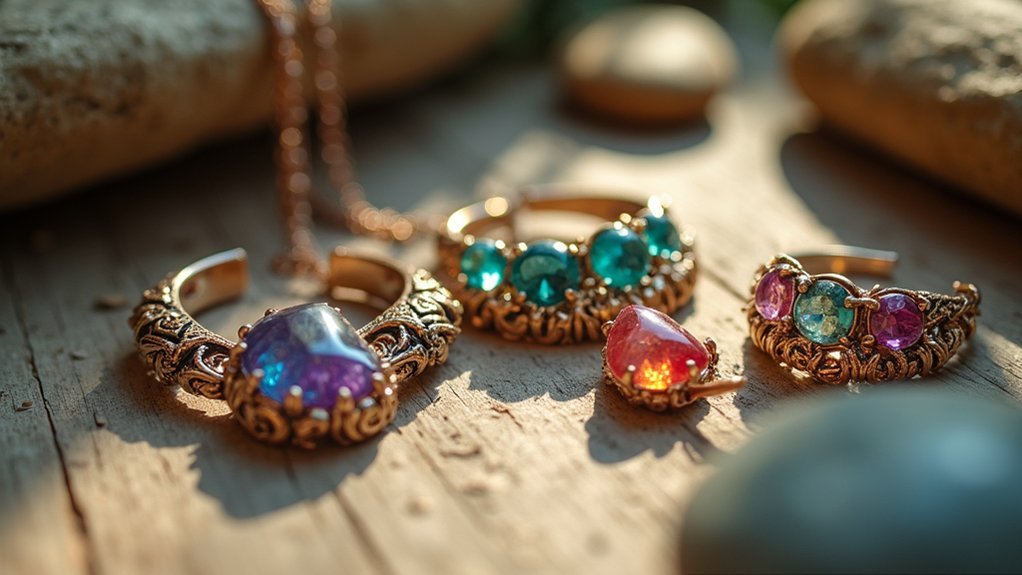
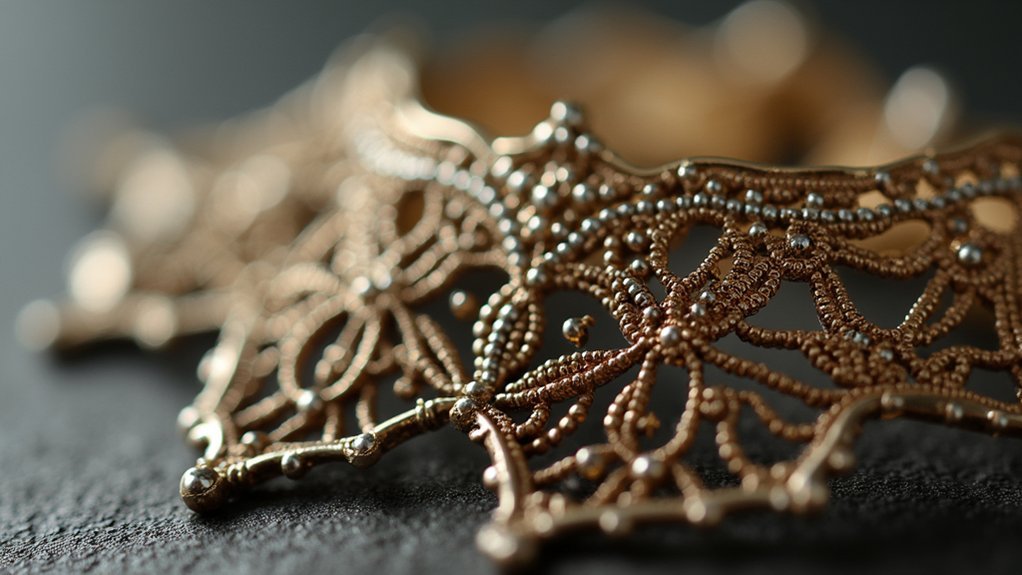
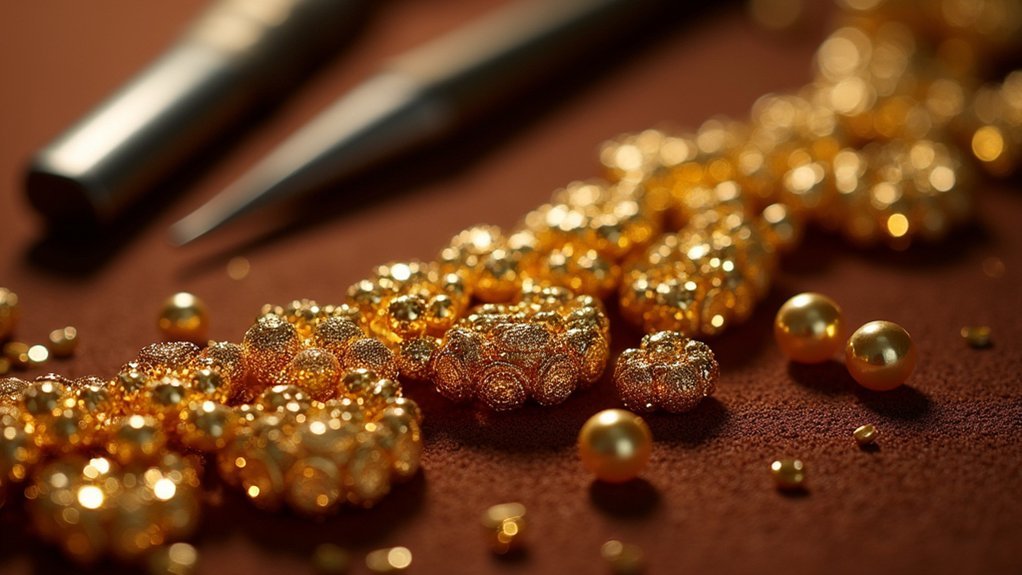
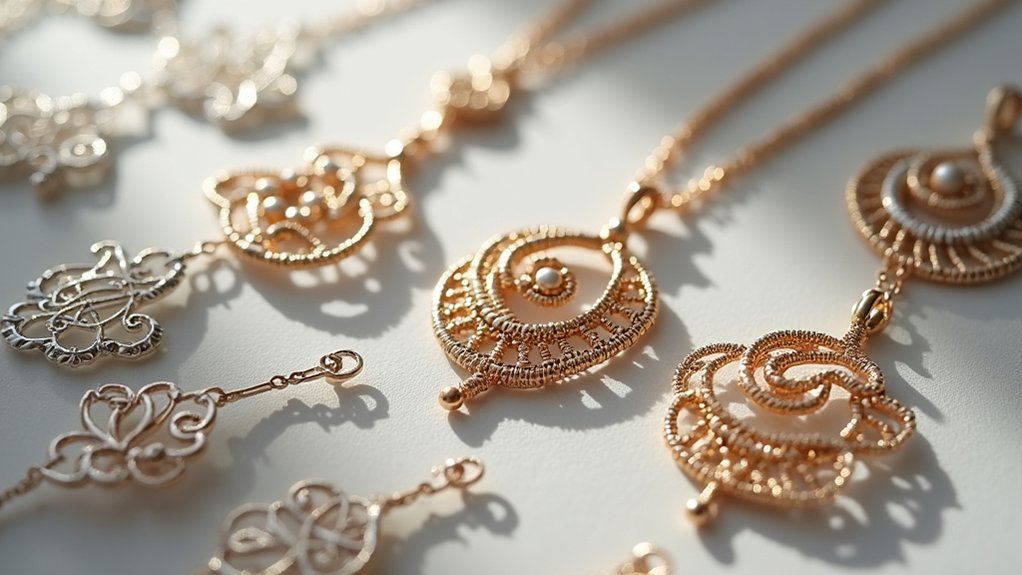
Leave a Reply